Class 10 History Chapter 1 Notes - The Rise of Nationalism in Europe
Frédéric Sorrieu Vision of World
In 1848, Frédéric Sorrieu, a French artist, created a series of prints depicting his vision of a world composed of democratic and social Republics.
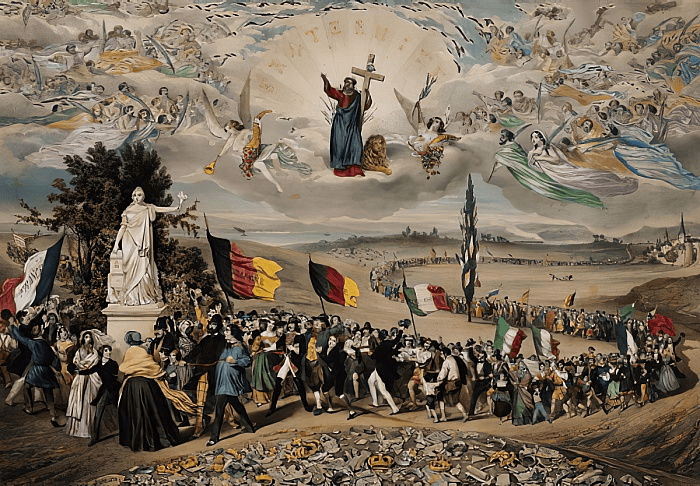 The Dream of Worldwide Democratic and Social Republics – The Pact Between Nations, a print prepared by Frédéric Sorrieu, 1848.
The Dream of Worldwide Democratic and Social Republics – The Pact Between Nations, a print prepared by Frédéric Sorrieu, 1848.
- The first print shows people from Europe and America of all ages and social classes marching in a procession, paying tribute to the Statue of Liberty, symbolizing freedom and enlightenment.
- Liberty is portrayed as a female figure holding the torch of Enlightenment and the Charter of the Rights of Man.
- The scene includes shattered symbols of absolutist institutions, representing the overthrow of oppressive regimes.
- Different nations are depicted through flags and national costumes, with the United States and Switzerland leading the procession.
- France, Germany, Austria, and other nations follow, reflecting the aspirations for nationhood and democracy prevalent in 1848.
- Christ, saints, and angels observing from above symbolize fraternity among nations.
- Nationalism emerged in the 19th century, leading to the rise of nation-states and the decline of multi-national empires in Europe.
- Nation-states involved centralized power over defined territories, with citizens sharing a common identity and history.
- This common identity is forged through struggles and shared experiences, which shape the concept of nation-states and nationalism in Europe.
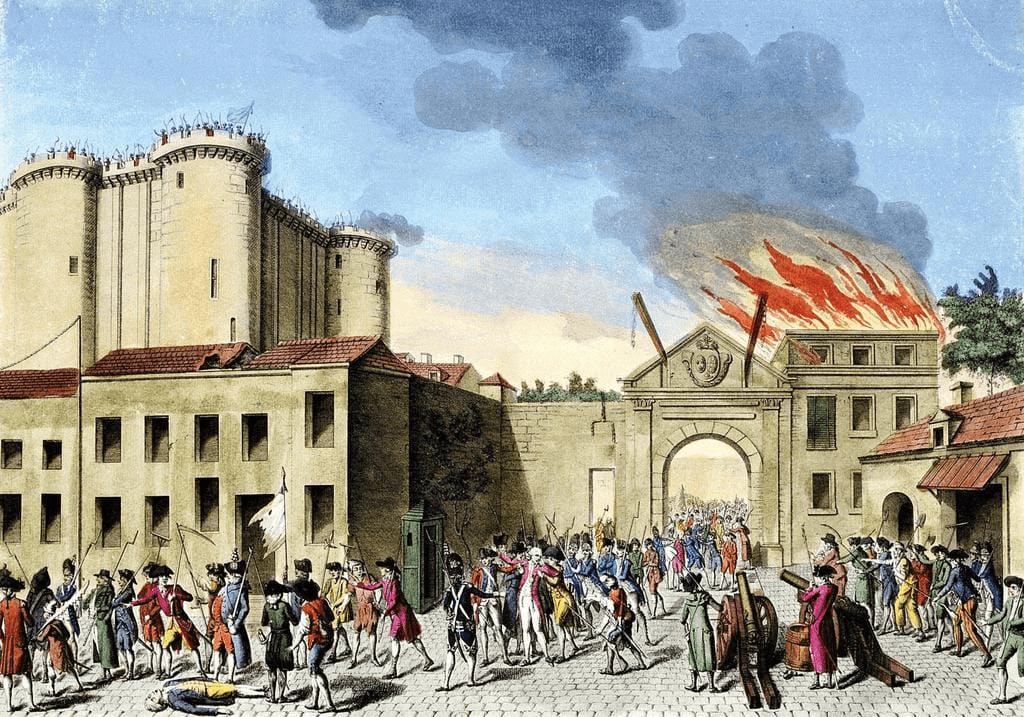 The Storming of Bastille
The Storming of Bastille
The French Revolution & the Idea of a Nation
- The concept of nationalism emerged prominently during the French Revolution in 1789.
- France was a complete territorial state ruled by an absolute monarch before the revolution.
- The French Revolution brought significant political and constitutional changes transferring sovereignty from the monarchy to French citizens.
- The revolution emphasized that the people, not the monarchy, would form the nation and determine its fate.
- French revolutionaries implemented various measures to foster a shared identity among the French populace.
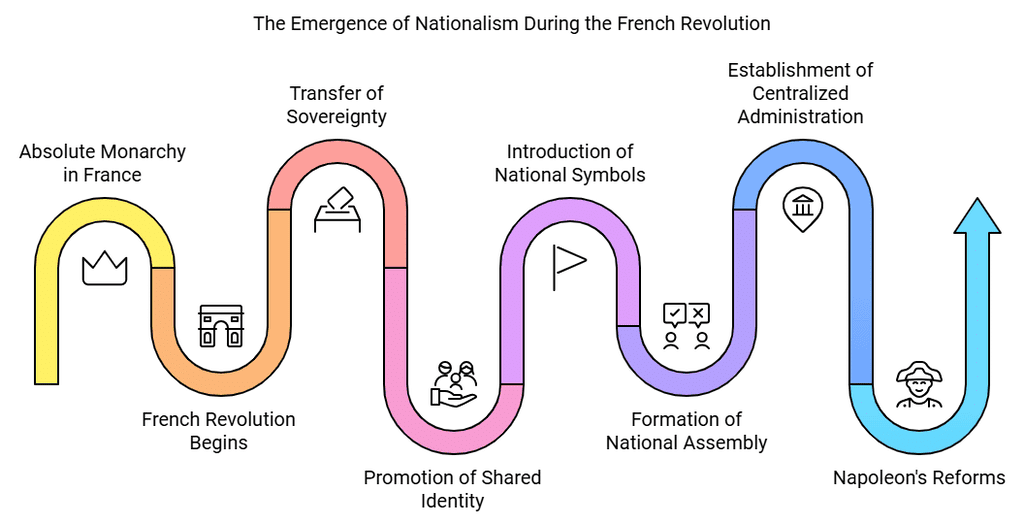
- Notions like la patrie (the fatherland) and le citoyen (the citizen) promoted a united community with equal rights under a constitution.
- Symbols of national unity were introduced, such as the tricolor flag replacing the royal standard.
- The Estates General transformed into the National Assembly, elected by active citizens.
- New customs like hymns, oaths, and commemorations emphasized national pride.
- A centralized administration was established with uniform laws, currency, and language across the nation.
- Napoleon, extending French influence, introduced reforms like the Napoleonic Code, promoting equality and property rights.
- Under Napoleon, administrative reforms were implemented across regions under French control, simplifying divisions and abolishing feudal systems.
- French rule received mixed reactions in conquered territories, initially welcomed but later met with resistance due to increased taxation and lack of political freedom.
The Making of Nationalism in Europe
- In the mid-eighteenth century, Europe was not composed of nation-states as we recognize them today.
- Regions like Germany, Italy, and Switzerland were fragmented into kingdoms, duchies, and cantons with their own rulers and territories.
- Eastern and Central Europe were under autocratic monarchies where diverse peoples lived without a shared identity or culture.
- The Habsburg Empire, ruling over Austria-Hungary, was a mosaic of varied regions and peoples.
- It encompassed regions like the Tyrol, Austria, the Sudetenland, Bohemia, Lombardy, Venetia, Hungary, Galicia, and Transylvania.
- People within the empire spoke different languages and belonged to distinct ethnic groups.
- The diversity within the empire hindered the development of a sense of political unity.
- Various groups were loyal to the emperor but did not share a common identity or culture.
- The idea of nationalism and nation-states began to evolve due to the lack of shared identity among diverse groups.
- People began to identify with the concept of a nation and sought political unity through commonalities.
- These movements laid the foundation for the eventual formation of nation-states.

The Aristocracy and the New Middle Class
- Socially and politically, a landed aristocracy was the dominant class on the continent.
- The members of this class shared a common way of life cutting across regional divisions.
- They owned estates both in the countryside and in towns.
- French was often spoken in diplomacy and high society.
- Family connections were often maintained through marriages.
- Although powerful, the aristocracy was a numerically small group.
- The majority of the population consisted of the peasantry.
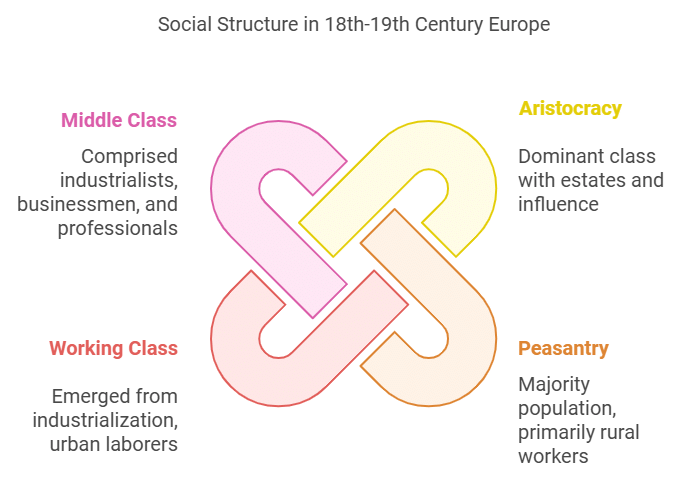
- In Western Europe, land was mainly farmed by tenants and small owners, while in Eastern and Central Europe, vast estates were worked by serfs.
- Industrial production and trade led to the growth of towns and the emergence of commercial classes in Western Europe and parts of Central Europe.
- Industrialization began in England in the late 18th century but occurred later in France and parts of Germany.
- New social groups emerged, including a working-class population and middle classes comprising industrialists, businessmen, and professionals.
- In Central and Eastern Europe, these groups were smaller in number until the late 19th century.
- Ideas of national unity gained popularity among the educated, liberal middle classes after aristocratic privileges were abolished.
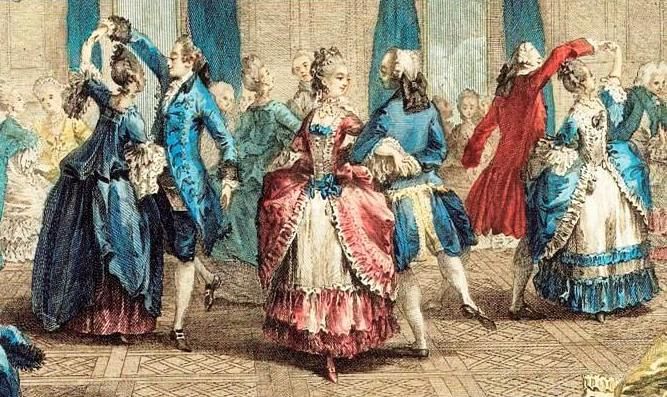 French Aristocrats
French Aristocrats
What did Liberal Nationalism Stand for?
- Liberal Nationalism in early 19th-century Europe was closely linked with liberalism, which emphasizes freedom and equality.
- Liberalism, rooted in the Latin word "liber" for free, symbolized liberty for individuals and equality under the law for the burgeoning middle classes.
- Politically, liberalism advocated for governance based on consent, marking a shift from autocracy and clerical privileges towards constitutional government and parliamentary representation.
- Nineteenth-century liberals prioritized private property rights and the concept of government by the people through elected representatives.

- However, equal treatment before the law did not always translate to universal suffrage, as seen in early democratic experiments like revolutionary France where only property-owning men could vote.
- Throughout the 19th and early 20th centuries, movements emerged advocating for equal political rights for women and non-propertied men.
- Economically, liberalism supported free markets by opposing state-imposed restrictions on the movement of goods and capital.
- In the German-speaking regions during the early 19th century, the emergence of a customs union, the Zollverein, aimed to streamline trade by abolishing tariffs and reducing the number of currencies.
- The Zollverein, initiated by Prussia and joined by other German states, facilitated economic growth by allowing the free flow of goods, people, and capital, reinforced by the development of a railway network.
- This economic nationalism further bolstered broader nationalist sentiments, promoting economic exchange and national unity.
A New Conservatism after 1815
- After Napoleon's 1815 defeat, European governments leaned towards conservatism, aiming to uphold traditional institutions like the monarchy, the Church, social hierarchies, property, and family.
- Conservatives recognized that modernization could benefit traditional institutions, making state power more robust through advancements like a modern army, efficient bureaucracy, a dynamic economy, and the end of feudalism.
- The Congress of Vienna in 1815, involving powers like Britain, Russia, Prussia, and Austria, sought to reverse many changes brought by Napoleon, restoring the Bourbon dynasty in France and establishing new states to contain French expansion.
- Prussia and Austria gained territories, while Russia and Prussia acquired parts of Poland and Saxony, respectively, with the primary goal of reinstating overthrown monarchies and establishing a conservative European order.
- Post-1815 conservative regimes were autocratic, suppressing dissent and instituting censorship to quell challenges to autocratic rule, despite liberal ideals from the French Revolution persisting and inspiring movements like advocating for press freedom.
The Revolutionaries
- In 1815, secret societies were formed in many European states to train revolutionaries and spread their ideas. Revolutionary opposed monarchical forms, and fight for liberty and freedom.
- Most of these revolutionaries also saw the creation of nation-states as a necessary part of this struggle for freedom.
- The Italian revolutionary Giuseppe Mazzini, born in Genoa in 1807, founded two more underground societies, first, Young Italy in Marseilles.
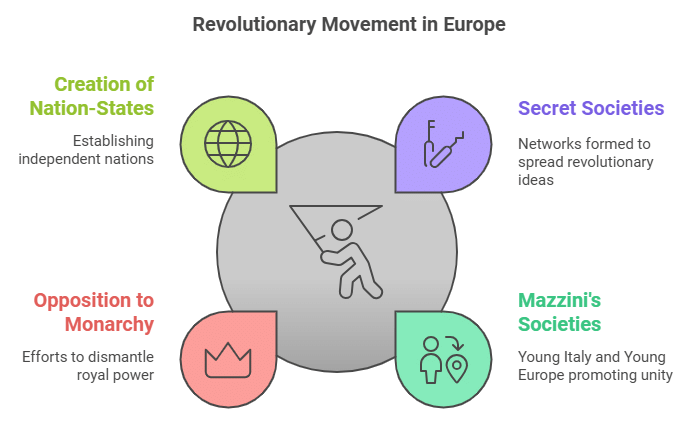
- Secondly, he founded Young Europe in Berne, whose members were like-minded young men from Poland, France, Italy, and the German states.
- Following his model, secret societies were set up in Germany, France, Switzerland, and Poland.
- Mazzini's relentless opposition to monarchy and his vision of democratic republics frightened the conservatives.
- Metternich described him as 'the most dangerous enemy of our social order'.
The Age of Revolutions: 1830-1848
- The period from 1830 to 1848 was known as "The Age of Revolutions."
- In Europe, as conservative governments sought to strengthen their power, ideas of liberalism and nationalism became linked with revolutionary movements.
- These revolutions occurred in various European regions like the Italian and German states, parts of the Ottoman Empire, Ireland, and Poland.
- The revolutions were primarily led by liberal nationalists from the educated middle-class elite, including professors, schoolteachers, clerks, and members of the commercial middle classes.
- The first major uprising happened in France in July 1830, where the Bourbon monarchy was overthrown by liberal revolutionaries who established a constitutional monarchy headed by Louis Philippe.
- The July Revolution in France inspired a similar movement in Brussels, leading to the separation of Belgium from the United Kingdom of the Netherlands.
- The Greek War of Independence ignited nationalist sentiments across Europe, as Greece had been under Ottoman rule since the 15th century.
- Revolutionary nationalism in Europe fueled the Greek struggle for independence that began in 1821, supported by exiled Greeks and sympathizers from Western Europe.
- Prominent figures like Lord Byron supported the Greek cause, emphasizing Greece's importance as the cradle of European civilization.
- Lord Byron organized financial aid and joined the conflict, ultimately passing away in 1824 due to illness.
- The Treaty ofConstantinople in 1832 officially recognized Greece as an independent nation.
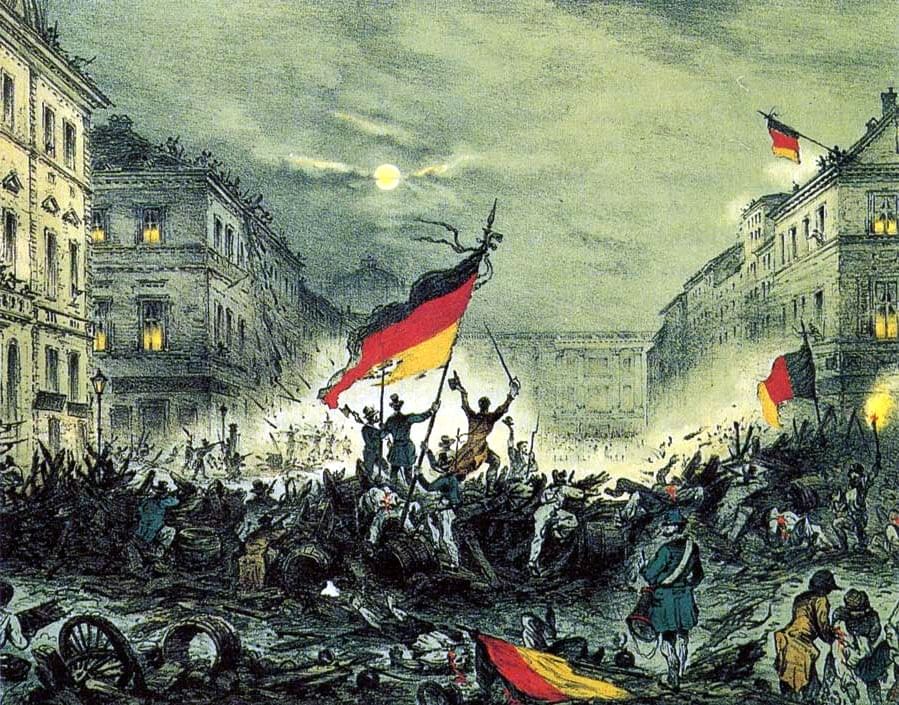 Revolutionaries in Berlin in March 1848, waving the revolutionaries flags
Revolutionaries in Berlin in March 1848, waving the revolutionaries flags
The Romantic Imagination and National Feeling
- Nationalism didn't just arise from wars and territorial expansion; culture also played a crucial role in shaping the idea of the nation.
- Art, poetry, stories, and music played an instrumental role in expressing and shaping nationalist sentiments.
- Romanticism was a cultural movement that aimed to cultivate a unique form of nationalist emotion.
- Romantic artists and poets critiqued the exaltation of reason and science, focusing instead on emotions, intuition, and mystical feelings.
- They sought to establish a sense of shared collective heritage and a common cultural past as the foundation of a nation.
- German philosopher Johann Gottfried Herder emphasized discovering true German culture among the common people.
- The essence of the nation (volksgeist) was promoted through folk songs, poetry, and dances.
- Collecting and preserving folk culture was vital for the project of nation-building.
- Emphasis on vernacular language and local folklore aimed at connecting with large illiterate audiences.
- Polish language and culture were suppressed after the Russian occupation, but efforts to revive national feelings persisted.
- Karol Kurpinski used music and operas to celebrate the national struggle, elevating folk dances as nationalist symbols.
- Language became a weapon of national resistance in Poland, with clergy using Polish for religious purposes against Russian dominance.
Hunger, Hardship and Popular Revolt
- The 1830s in Europe were marked by severe economic difficulties.
- Population growth led to a surplus of job seekers and a shortage of jobs.
- Rural residents moved to cities, living in overcrowded slums.
- Local producers faced tough competition from cheap English goods due to industrialization.
- Textile production, mainly in homes or small workshops, faced competition from mechanized English production.
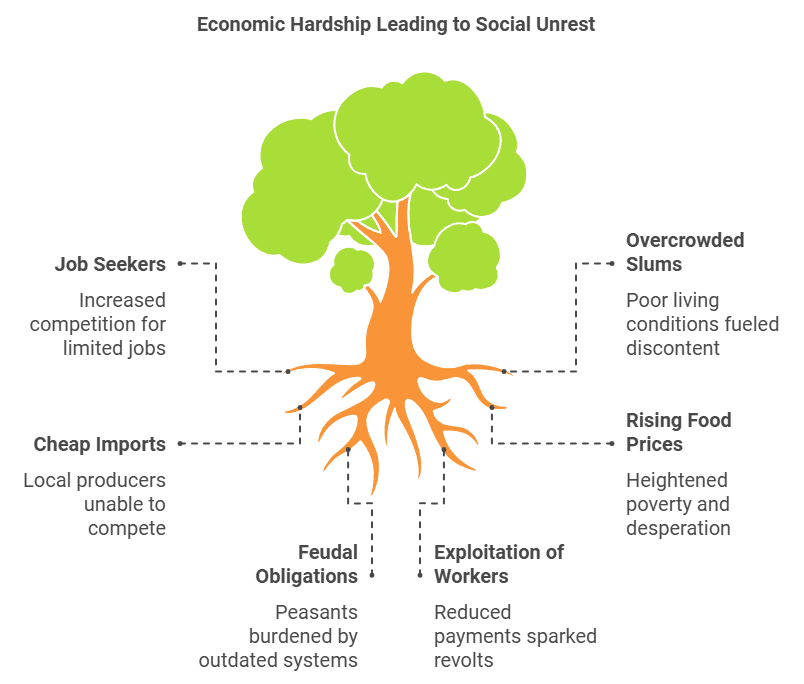
- Peasants in regions with powerful aristocracies suffered from feudal obligations.
- Rising food prices and poor harvests worsened poverty in both urban and rural areas.
- In 1848, food shortages and unemployment triggered unrest in Paris, leading to Louis Philippe's ousting.
- A Republic was declared, suffrage was extended to adult males, and the right to work was guaranteed.
- National workshops were established to provide employment.
- In 1845, weavers in Silesia revolted against contractors who exploited them by reducing payments.
- Weavers demanded higher wages, leading to clashes with the contractor and eventual military intervention.
- The conflict resulted in the death of eleven weavers.
1848: The Revolution of the Liberals
- Occurred alongside uprisings of impoverished, unemployed, and hungry peasants and workers across Europe.
- In 1848, a revolution led by the educated middle classes was unfolding.
- In France, events in February led to the abdication of the monarch and the establishment of a republic with universal male suffrage.
- In countries like Germany, Italy, Poland, and the Austro-Hungarian Empire, liberal middle-class individuals demanded constitutionalism and national unification.
- They sought to establish a nation-state based on parliamentary principles, including a constitution, freedom of the press, and freedom of association.
- In Germany, various political groups composed of professionals, businessmen, and successful artisans convened in Frankfurt to form an all-German National Assembly.
- On May 18, 1848, 831 elected representatives gathered in Frankfurt to draft a constitution for a German nation with a monarch subject to parliamentary oversight.
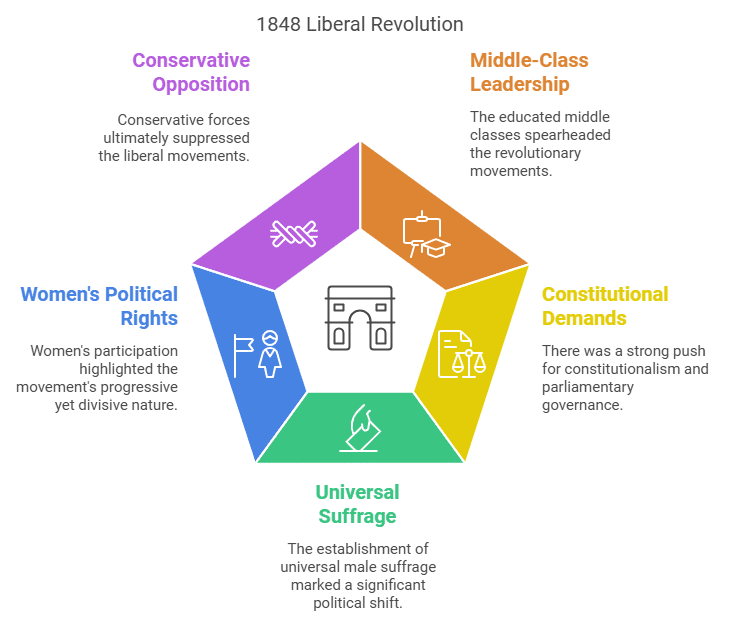
- King Friedrich Wilhelm IV of Prussia rejected the terms offered by the assembly, aligning with other monarchs to oppose the elected body.
- The parliament faced increasing opposition from the aristocracy and military, losing support from workers and artisans.
- The parliament, dominated by the middle class, eventually disbanded after troops intervened.
- Political rights for women were a divisive issue within the liberal movement despite active female participation in political activities.
- Women were not granted suffrage during the Assembly elections and were only allowed as observers in the visitors' gallery at the Church of St Paul.
- Conservative forces suppressed liberal movements in 1848, leading to a realization among monarchs that concessions to liberal-nationalist revolutionaries were necessary to prevent cycles of revolution and repression.
- Following 1848, autocratic monarchies in Central and Eastern Europe began implementing changes witnessed in Western Europe before 1815, such as the abolition of serfdom and bonded labor.
- The Habsburg rulers granted more autonomy to Hungarians in 1867 as part of the reforms.
The Making of Germany and Italy
Germany – Can the Army be the Architect of a Nation?
- After 1848, nationalism in Europe shifted away from democracy and revolution.
- Nationalist feelings were often manipulated by conservatives to strengthen state power and gain political control.
- Germany and Italy underwent a process of unification as nation-states.
- German middle-class individuals in 1848 attempted to unite the German confederation into a nation-state through an elected parliament.
- However, this liberal effort was suppressed by the monarchy, military, and Prussian landowners (Junkers).
- Prussia then took the lead in the movement for national unification, led by Otto von Bismarck.
- Through three wars in seven years (against Austria, Denmark, and France), Prussia emerged victorious, finalizing the unification process.
- In January 1871, King William I of Prussia was declared German Emperor in Versailles.
- The nation-building process in Germany highlighted the dominance of Prussian state power.
- The new German state focused on modernizing currency, banking, legal, and judicial systems, setting an example for the rest of Germany.
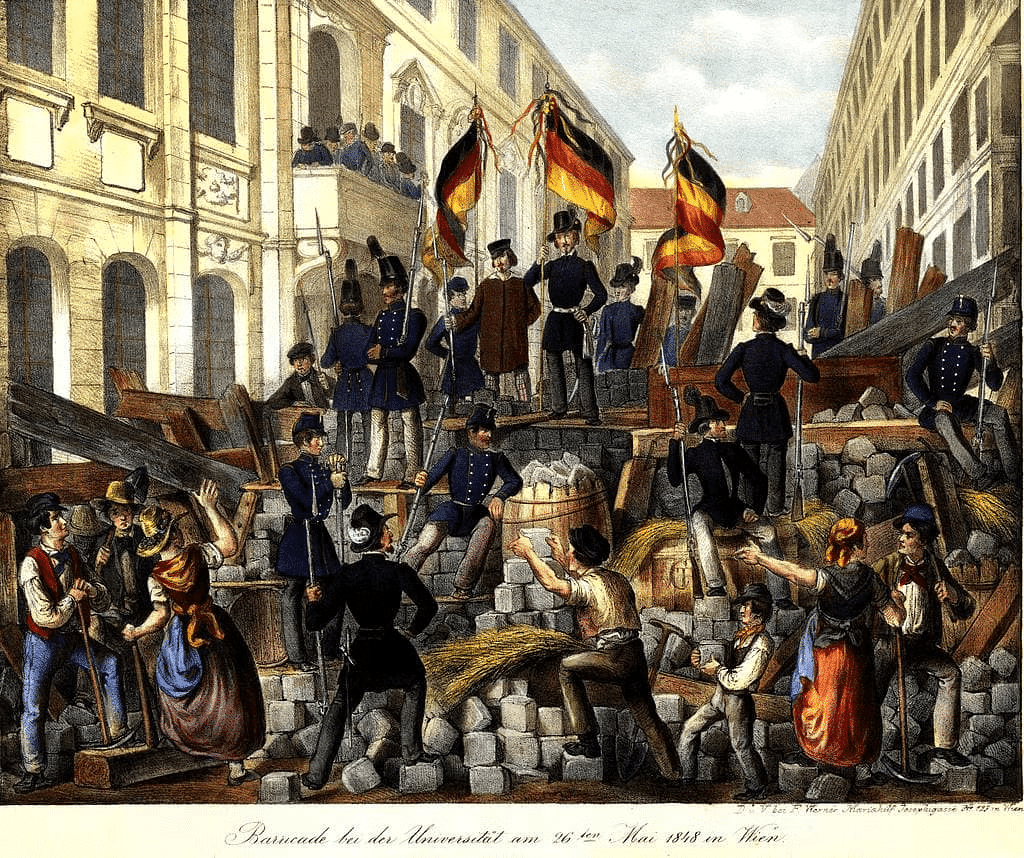
Italy Unified
- Italy, like Germany, had a history of political fragmentation.
- Italians were spread across different states and empires.
- Italy was divided into seven states, with only Sardinia-Piedmont ruled by an Italian princely house.
- The north was under Austrian Habsburg rule, the center under the Pope, and the south under Bourbon kings of Spain.
- The Italian language had various regional variations.
- Giuseppe Mazzini aimed for a unified Italian Republic and created Young Italy for this cause.
- Failed uprisings led to Sardinia-Piedmont taking the lead in unification under King Victor Emmanuel II.
- Cavour, a key figure, orchestrated a diplomatic alliance with France to defeat Austria and unify Italy.
- In 1860, armed volunteers led by Garibaldi helped unify Italy, with Victor Emmanuel II becoming king in 1861.
- Despite unification, many Italians were unaware of liberal-nationalist ideas, with high illiteracy rates among the masses.
The Strange Case of Britain
- The nation-state model in Britain evolved gradually rather than through sudden change.
- Prior to the 18th century, there wasn't a unified British identity; people identified more with their ethnic backgrounds like English, Welsh, Scot, or Irish.
- As England grew in wealth and power, it exerted influence over the other nations in the British Isles.
- The English Parliament, after gaining power from the monarchy in 1688, played a crucial role in forming a nation-state with England as its core.
- TheAct of Union in 1707 between England and Scotland led to the creation of the 'United Kingdom of Great Britain', consolidating English influence over Scotland.
- Scotland's unique culture and political institutions faced suppression as a British identity emerged, leading to the marginalization of Scottish traditions.
- In Ireland, deep divisions between Catholics and Protestants existed, with English support aiding Protestant dominance over a predominantly Catholic nation.
- Rebellions against British control, like the one led by Wolfe Tone and the United Irishmen in 1798, were quashed, eventually leading to Ireland's inclusion in the United Kingdom in 1801.
- A new British identity was constructed, emphasizing English culture and symbols like the Union Jack and the English language, relegating older nations to subordinate roles in the union.
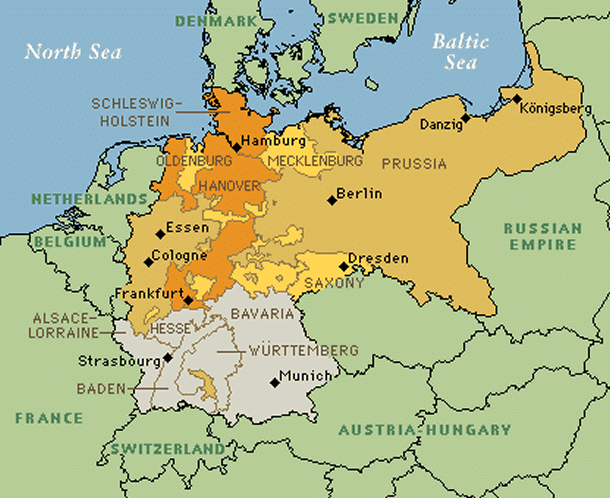 Map: Unification of Germany
Map: Unification of Germany
Visualising the Nation
- Artists in the 18th and 19th centuries personified nations by representing them as female figures.
- The chosen female form symbolized the nation as a personification, not a specific real-life woman.
- Female allegories, such as Marianne in France and Germania in Germany, were created to embody the nation.
- During the French Revolution, Liberty, Justice, and the Republic were depicted using symbols like the red cap, broken chain, blindfolded woman with weighing scales.
- Marianne, symbolizing France, was associated with the red cap, tricolour, and cockade, with statues erected in public places as a symbol of unity.
- Germania, symbolizing Germany, wore a crown of oak leaves to represent heroism in visual representations.
- These allegorical figures were used on coins, stamps, and public monuments to instill a sense of national identity.
Nationalism and Imperialism
- Nationalism evolved from an idealistic sentiment to a narrow creed by the late 1800s.
- Nationalist groups grew intolerant and war-ready, while major European powers exploited these sentiments for imperialism.
- The Balkans, encompassing various modern countries, experienced heightened nationalist tensions post-1871.
- Under Ottoman control, the Balkans saw the rise of romantic nationalism and the empire's decline.
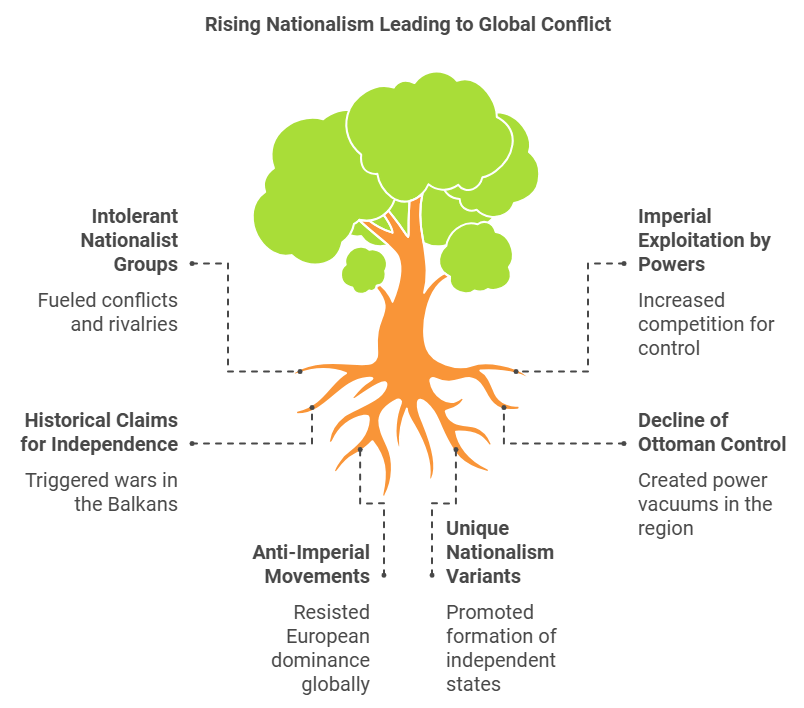
- Balkan nations sought independence based on historical claims, leading to conflicts and power rivalries.
- European powers like Russia, Germany, England, and Austro-Hungary vied for control over the Balkans, sparking wars.
- Intense competition over trade, colonies, and military strength culminated in the outbreak of World War I in 1914.
- Colonized nations globally began resisting European dominance, fostering anti-imperial movements.
- These movements aimed to establish independent nation-states, driven by collective national unity and opposition to imperialism.
- Unique varieties of nationalism emerged worldwide, emphasizing the natural organization of societies into nation-states.
|
66 videos|614 docs|79 tests
|
FAQs on Class 10 History Chapter 1 Notes - The Rise of Nationalism in Europe
| 1. What was Frédéric Sorrieu's vision of a world united by nationalism? |  |
| 2. How did the French Revolution influence the idea of a nation? |  |
| 3. What were the key events during the Age of Revolutions (1830-1848) that contributed to the rise of nationalism in Europe? |  |
| 4. How did nationalism contribute to the unification of Germany and Italy? |  |
| 5. What is the relationship between nationalism and imperialism in the context of European history? |  |

















